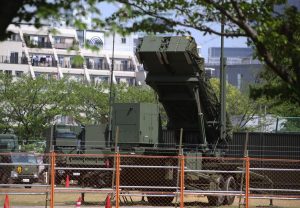Trump Says China Pressuring North Korea on Missile, Nukes
The Stream - Sunday April 30, 2017
by Foster Klug Kim Tong Hyung

SEOUL, South Korea (AP) -- President Donald Trump said in a television interview to be aired Sunday that he believes China’s president has been putting pressure on North Korea as it pursues its missile and nuclear weapons programs.
In an interview with CBS’ Face the Nation, Trump said he won’t be happy if North Korea conducts a nuclear test and that he believes Chinese President Xi Jinping won’t be happy, either.
Asked if that means military action, Trump responded: “I don’t know. I mean, we’ll see.”
On Saturday, a North Korean mid-range ballistic missile apparently failed shortly after launch, the third test-fire flop this month but a clear message of defiance. North Korean ballistic missile tests are banned by the United Nations because they’re seen as part of the North’s push for a nuclear-tipped missile that can hit the U.S. mainland.
The launch comes at a point of particularly high tension in the region. Trump has sent a nuclear-powered submarine and the USS Carl Vinson aircraft supercarrier to Korean waters and North Korea last week conducted large-scale, live-fire exercises on its eastern coast. The U.S. and South Korea also started installing a missile defense system that is supposed to be partially operational within days and their two navies are staging joint military drills.
Residents in the village of Seongj, where the missile defense system is being installed, scuffled with police on Sunday. About 300 protesters faced off against 800 police and succeeded in blocking two U.S. Army oil trucks from entering the site, local media reported. A few residents were injured or fainted from the scuffle and were transported to a hospital.
The Terminal High-Altitude Area Defense system, or THAAD, remains a controversial topic in South Korea and presidential front-runner Moon Jae-in even has vowed to reconsider the deployment if he wins the May 9 election. He has said that the security benefits of THAAD would be offset by worsened relations with China, which is the country’s biggest trading partner and is opposed to its deployment.
Trump raised eyebrows in South Korea last week when he said would make Seoul pay $1 billion for the missile defense system. Seoul’s presidential Blue House said Sunday that White House National Security Adviser H. R. McMaster confirmed that the U.S. will not be seeking money for the system.
North Korea didn’t immediately comment on its latest missile launch, though its state media on Saturday reiterated the country’s goal of being able to strike the continental U.S.
South Korea’s Foreign Ministry denounced the launch as an “obvious” violation of United Nations resolutions and the latest display of North Korea’s “belligerence and recklessness.”
“We sternly warn that the North Korean government will continue to face a variety of strong punitive measures issued by the U.N. Security Council and others if it continues to reject denuclearization and play with fire in front of the world,” the ministry said.
South Korea’s Joint Chiefs of Staff said in a statement that the missile flew for several minutes and reached a maximum height of 71 kilometers (44 miles) before it apparently failed.
It didn’t immediately provide an estimate on how far the missile flew, but a U.S. official, speaking on condition of anonymity to discuss sensitive matters, said it was likely a medium-range KN-17 ballistic missile. It broke up a few minutes after the launch.
Japan’s Chief Cabinet Secretary Yoshihide Suga, speaking after a meeting of Japan’s National Security Council, said the missile is believed to have traveled about 50 kilometers (30 miles) and fallen on an inland part of North Korea.
Analysts say the KN-17 is a new Scud-type missile developed by North Korea. The North fired the same type of missile April 16, just a day after a massive military parade where it showed off its expanding missile arsenal, but U.S. officials called that launch a failure.
Some analysts say a missile the North test fired April 5, which U.S. officials identified as a Scud variant, also might have been a KN-17. U.S. officials said that missile spun out of control and crashed into the sea.
Moon Seong Mook, a South Korean analyst and former military official, says that the North would gain valuable knowledge even from failed launches as it continues to improve its technologies for missiles. The South Korean and Japanese assessments about Saturday’s launch indicate that the North fired the missile from a higher-than-normal angle to prevent it from flying too far, he said.
“They could be testing a variety of things, such as the thrust of the rocket engine or the separation of stages,” Moon said. “A failure is a failure, but that doesn’t mean the launch was meaningless.”
The two earlier launches were conducted from an eastern coastal area, but Saturday’s missile was fired in the west, from an area near Pukchang, just north of the capital, Pyongyang.
Pope Francis warned that “a good part of humanity” will be destroyed if tensions with North Korea escalate, and he called for diplomacy and a revived United Nations to take the lead in negotiating a resolution.
Francis was asked as he traveled back to Rome from Egypt on Saturday local time (early Sunday morning Seoul time) about North Korean ballistic missile tests and U.S. warnings of “catastrophic” consequences if the world fails to stop them.
“Today, a wider war will destroy not a small part of humanity, but a good part of humanity and culture. Everything. Everything, no? It would be terrible. I don’t think humanity today could bear it,” he told reporters
___
AP writers Matthew Pennington and Lolita C. Baldor in Washington and Edith Lederer at the United Nations contributed to this story.
Copyright 2017 The Associated Press. All rights reserved. This material may not be published, broadcast, rewritten or redistributed.
Read More Here
No comments:
Post a Comment